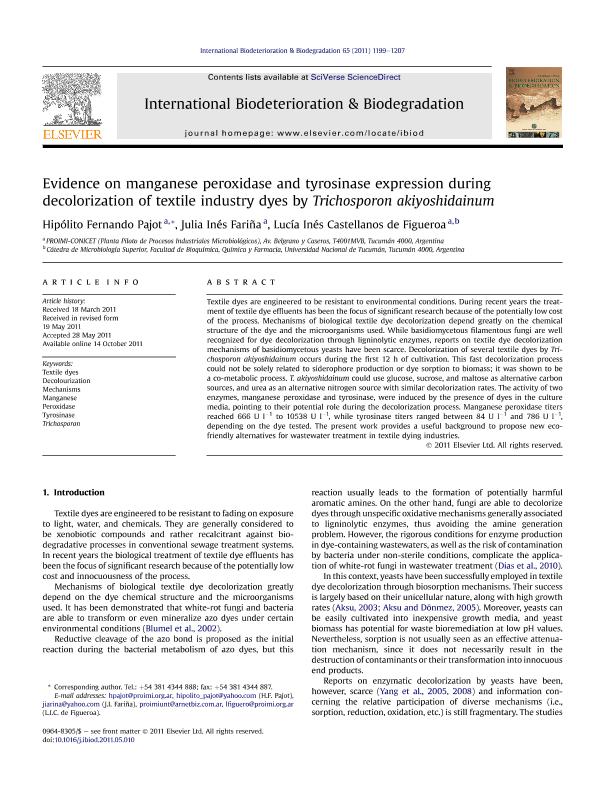Mostrar el registro sencillo del ítem
dc.contributor.author
Pajot, Hipólito Fernando

dc.contributor.author
Fariña, Julia Inés

dc.contributor.author
Castellanos de Figueroa, Lucia Ines

dc.date.available
2017-05-31T18:16:57Z
dc.date.issued
2011-11
dc.identifier.citation
Pajot, Hipólito Fernando; Fariña, Julia Inés; Castellanos de Figueroa, Lucia Ines; Evidence on manganese peroxidase and tyrosinase expression during decolourization of textile industry dyes by Trichosporon akiyoshidainum; Elsevier; International Biodeterioration And Biodegradation; 65; 8; 11-2011; 1199-1207
dc.identifier.issn
0964-8305
dc.identifier.uri
http://hdl.handle.net/11336/17170
dc.description.abstract
Textile dyes are engineered to be resistant to environmental conditions. During recent years the treatment of textile dye effluents has been the focus of significant research because of the potentially low cost of the process. Mechanisms of biological textile dye decolorization depend greatly on the chemical structure of the dye and the microorganisms used. While basidiomycetous filamentous fungi are well recognized for dye decolorization through ligninolytic enzymes, reports on textile dye decolorization mechanisms of basidiomycetous yeasts have been scarce. Decolorization of several textile dyes by Trichosporon akiyoshidainum occurs during the first 12 h of cultivation. This fast decolorization process could not be solely related to siderophore production or dye sorption to biomass; it was shown to be a co-metabolic process. T. akiyoshidainum could use glucose, sucrose, and maltose as alternative carbon sources, and urea as an alternative nitrogen source with similar decolorization rates. The activity of two enzymes, manganese peroxidase and tyrosinase, were induced by the presence of dyes in the culture media, pointing to their potential role during the decolorization process. Manganese peroxidase titers reached 666 U l 1 to 10538 U l 1, while tyrosinase titers ranged between 84 U l 1 and 786 U l 1, depending on the dye tested. The present work provides a useful background to propose new ecofriendly alternatives for wastewater treatment in textile dying industries.
dc.format
application/pdf
dc.language.iso
eng
dc.publisher
Elsevier

dc.rights
info:eu-repo/semantics/openAccess
dc.rights.uri
https://creativecommons.org/licenses/by-nc-nd/2.5/ar/
dc.subject
Trichosporon Akiyoshidainum
dc.subject
Decolourization
dc.subject
Textile Industry Dyes
dc.subject
Manganese
dc.subject
Peroxidase
dc.subject.classification
Biología Celular, Microbiología

dc.subject.classification
Ciencias Biológicas

dc.subject.classification
CIENCIAS NATURALES Y EXACTAS

dc.title
Evidence on manganese peroxidase and tyrosinase expression during decolourization of textile industry dyes by Trichosporon akiyoshidainum
dc.type
info:eu-repo/semantics/article
dc.type
info:ar-repo/semantics/artículo
dc.type
info:eu-repo/semantics/publishedVersion
dc.date.updated
2016-02-05T14:59:20Z
dc.journal.volume
65
dc.journal.number
8
dc.journal.pagination
1199-1207
dc.journal.pais
Países Bajos

dc.journal.ciudad
Amsterdam
dc.description.fil
Fil: Pajot, Hipólito Fernando. Consejo Nacional de Investigaciones Científicas y Técnicas. Centro Científico Tecnológico Tucumán. Planta Piloto de Procesos Industriales Microbiológicos (i); Argentina
dc.description.fil
Fil: Fariña, Julia Inés. Consejo Nacional de Investigaciones Científicas y Técnicas. Centro Científico Tecnológico Tucumán. Planta Piloto de Procesos Industriales Microbiológicos (i); Argentina
dc.description.fil
Fil: Castellanos de Figueroa, Lucia Ines. Consejo Nacional de Investigaciones Científicas y Técnicas. Centro Científico Tecnológico Tucumán. Planta Piloto de Procesos Industriales Microbiológicos (i); Argentina. Universidad Nacional de Tucumán; Argentina
dc.journal.title
International Biodeterioration And Biodegradation

dc.relation.alternativeid
info:eu-repo/semantics/altIdentifier/doi/http://dx.doi.org/10.1016/j.ibiod.2011.05.010
dc.relation.alternativeid
info:eu-repo/semantics/altIdentifier/url/http://www.sciencedirect.com/science/article/pii/S0964830511002046
Archivos asociados
